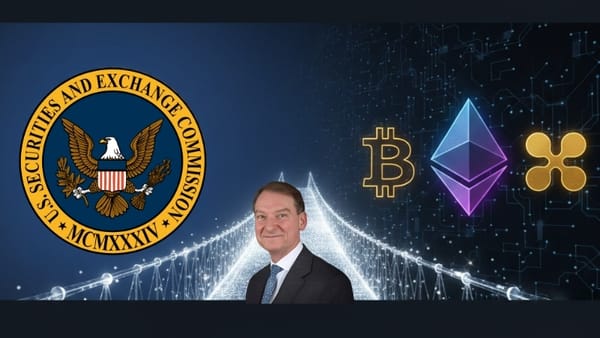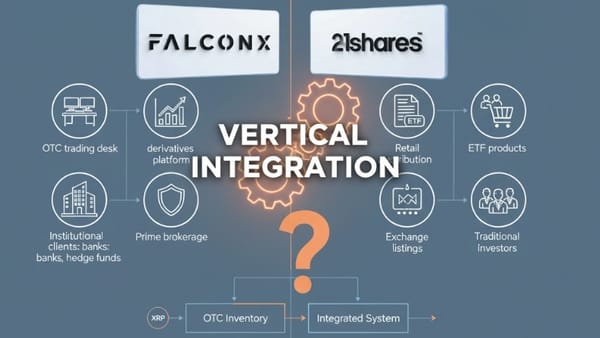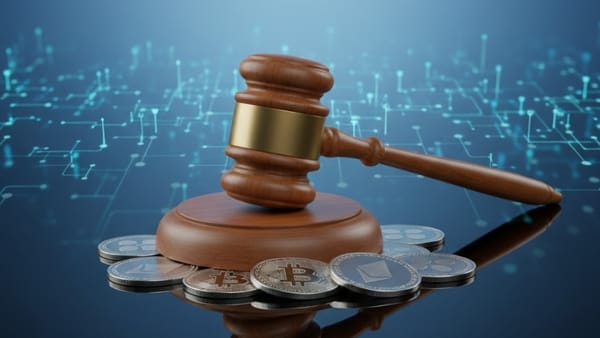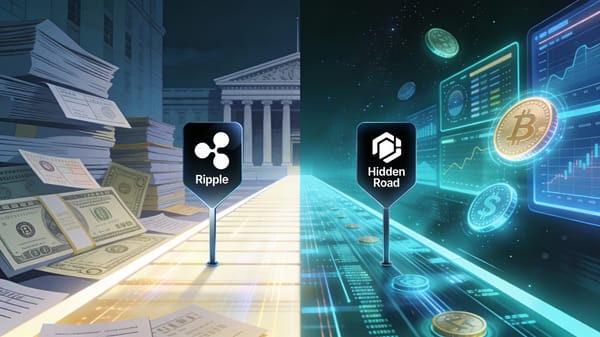XRP Emerges as the Financial Rails Revolution Banks Have Been Waiting For
Expert predictions suggest XRP could unlock trillions trapped in legacy banking systems and transform global settlement infrastructure within five years.
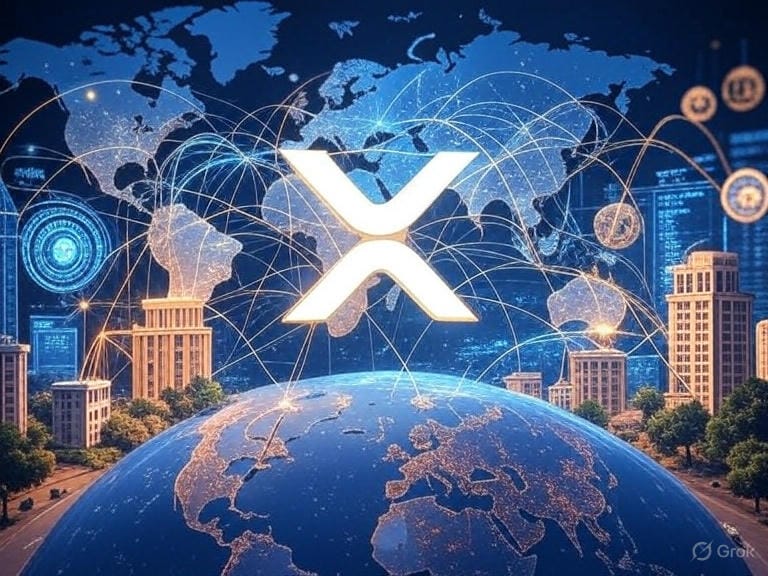
Expert predictions suggest XRP could unlock trillions trapped in legacy banking systems and transform global settlement infrastructure within five years.
The global financial system faces a $27 trillion liquidity crisis locked in nostro and vostro accounts, according to McKinsey research, while derivatives markets worth over $1 quadrillion struggle with antiquated settlement processes. Now, a growing chorus of financial experts, led by Digital Ascension Group CEO Jake Claver, believes XRP holds the key to revolutionizing these cash flow rails and unlocking unprecedented efficiency in the world's financial infrastructure.
The $27 Trillion Problem Traditional Banking Can't Solve
Traditional cross-border payments rely on a complex web of correspondent banking relationships where financial institutions must pre-fund accounts in multiple currencies. These nostro and vostro accounts tie up capital and add friction, with banks holding foreign currency balances that sit idle until needed for international transfers. McKinsey reported that in 2015, nostro balances around the world reached $27 trillion, and this figure has only grown as transnational payments increase.
Cross-border payments typically settle via correspondent banking, which involves two banks establishing reciprocal accounts with each other, creating highly interdependent relationships that restrict the flow of funds. This system not only locks up massive amounts of capital but also creates delays, with some international transfers taking anywhere from 3 to 10 days to complete.
Claver's Bold Vision: XRP as the Global Settlement Network
Jake Claver, CEO of Digital Ascension Group and managing director of Digital Wealth Partners, has emerged as one of the most vocal advocates for XRP's transformative potential. His firm has put its money where its mouth is, holding over $200 million worth of XRP as part of its long-term bet on the token's future role in powering tokenized asset settlements.
Claver emphasized that XRP operates as a high-volume liquidity and settlement network designed to handle trillions in daily transactions, arguing that valuing XRP using traditional market cap systems "does not make sense". He compared XRP's role to that of a global highway rather than a single product-producing company, suggesting that many investors are applying outdated valuation models to what is essentially financial infrastructure.
"XRP isn't a memecoin or a stock. It's a global settlement network that needs serious value to work at scale," Claver stated in a detailed analysis that challenges conventional thinking about XRP's market valuation.
The Technology That Makes It Possible
Claver compared XRP's potential to the early days of email systems, where users needed the same provider to communicate. Today, thanks to standard protocols, any email can reach any inbox. He believes XRP could do something similar for digital payments, bridging different apps and banking systems across borders.
The technology offers compelling advantages over traditional systems. Ripple Labs claims that the XRP Ledger can handle up to 3,400 transactions per second, dramatically more scalable than competitors like Bitcoin and Ethereum, with transactions completing in 3-5 seconds. This speed advantage is crucial for institutional applications where timing matters.
XRP eliminates the need for correspondent banking by representing an actual transfer of value, not just information about a credit or debit. As part of a real-time gross settlement system (RTGS), when XRP is transferred, the full value is sent and verified instantly, freeing banks from the need to hold Nostro/Vostro accounts in different currencies.
Institutional Adoption Accelerates
Recent developments suggest institutional adoption is accelerating rapidly. Japan plans to adopt XRP across almost all domestic banks by the end of 2025, driven by SBI Holdings and supported by the Bank of Japan to modernize its financial infrastructure. Meanwhile, following Ripple's legal victory against the SEC, U.S. banks are exploring integration of XRP and RLUSD into their systems to modernize outdated financial infrastructure.
Several banks, including Santander and the Commonwealth Bank of Australia, have confirmed strategic partnerships with Ripple Labs, attracted by technology that is faster and more affordable than traditional cross-border payment protocols. The international network of financial institutions, called RippleNet, uses Ripple's distributed technology to execute real-time settlement of international transactions, helping banks and payment providers frictionlessly transfer funds.
The Derivatives Market Opportunity
Perhaps the most compelling use case lies in the derivatives market. If XRP were to capture just 0.1% of the $1 quadrillion derivatives market, this would equate to $1 trillion in market activity, which could translate to approximately $10 per token given XRP's maximum supply of around 99.98 billion tokens.
Claver pointed to Project ION, a settlement platform developed in 2022 through a partnership between the DTCC and R3, noting that the system is already in place but needs a neutral, liquid bridge asset to connect different financial systems. According to him, XRP fits that need and could step in when the time comes.
The opportunity extends beyond traditional banking. The gross notional value of outstanding contracts in the over-the-counter (OTC) derivatives markets reached $595 trillion, with instantaneous cross-border transfer of digital tokens potentially eliminating cumbersome intraday collateral management processes required by existing wholesale settlement systems.
Expert Price Predictions and Timeline
Claver has made increasingly bold predictions about XRP's potential value as adoption scales. Speaking on The Good Morning Crypto show, Claver projected XRP could reach $1,500 to $2,000 by January 1, 2026, if certain global and market conditions align. His longer-term outlook is even more ambitious, with Claver arguing that XRP is "programmed" to reach approximately $10,000 per coin by 2027 to achieve significant efficiencies in moving large amounts of money for institutions.
The reasoning is based on network efficiency: at higher prices, XRP can move more money with fewer tokens. As Ripple CTO David Schwartz famously noted, moving $1 million with XRP requires 1 million tokens at $1 per token, but only 100,000 tokens at $10 per token.
Regulatory Clarity Creates New Opportunities
The regulatory landscape has dramatically improved for XRP adoption. Since Ripple settled the lawsuit with the SEC in March 2025, analysts believe this could trigger a new wave of institutional investment, with wider adoption in the financial sector leading to increased long-term demand for XRP.
The resolution of Ripple's legal battle with the U.S. Securities and Exchange Commission in late 2024 removed a critical barrier to institutional adoption. By affirming XRP's status as a non-security for secondary market transactions, the ruling legitimized XRP as a settlement and liquidity tool.
Real-World Implementation Examples
The theoretical potential is already being realized in practice. In July 2025, Ripple announced a landmark partnership with Ctrl Alt and the Dubai Land Department to tokenize real estate on the XRP Ledger, enabling fractional ownership, digital deeds, and blockchain-based property transfers.
Ripple brought the first digital commercial paper (DCP) to the XRPL in partnership with Zeconomy, administered by Guggenheim Treasury Services. The fixed income asset secured by U.S. Treasuries is rated Prime-1 by Moody's and is now part of XRPL's growing institutional-grade RWA suite.
The Central Bank Connection
Central bank adoption could provide the ultimate validation of XRP's utility. Ripple has teamed up with multiple central banks, with CEO Brad Garlinghouse stating that ten government partnerships are active. If 50 or more central banks adopt Ripple's CBDC platform and XRP plays a role in global settlement systems, the price could reach $20.38 per coin based on expert projections.
In scenarios where XRP becomes the go-to system for bank settlements across G20 countries, the price could climb to $42.46. In the most ambitious outcome, where central banks use XRP as a reserve or clearing asset, the market cap could hit $5 trillion, pushing the token to roughly $84.93.
Challenges and Realistic Assessments
Not all experts share Claver's extreme optimism. Critics point out that the majority of Ripple's bank partners use RippleNet technology without requiring XRP, and that stablecoins may offer banks the benefits of XRP without the volatility risk. Some analysts caution that XRP may not see explosive growth following regulatory clarity, with one expert suggesting the market would be lucky to see a 20% increase from current levels.
However, Claver emphasizes that holding XRP tokens means little without a clear strategy, boldly asserting that one could hold 1 million XRP tokens and still end up broke without proper planning. This focus on strategic thinking rather than mere accumulation reflects a maturing perspective on XRP's investment potential.
The Bottom Line: A New Financial Paradigm
The convergence of regulatory clarity, institutional adoption, and technological capability suggests XRP is positioned to play a central role in the next evolution of global finance. Whether Claver's ambitious price targets prove accurate or not, the underlying thesis appears sound: the world's financial infrastructure needs modernization, and XRP offers a compelling solution to longstanding inefficiencies.
As Claver notes, the future of finance will likely involve a world where assets like stocks, real estate, and digital currencies can be traded instantly and without middlemen. XRP's fast, scalable platform could play a pivotal role in this future, offering enterprise-level solutions for businesses and institutions.
For investors and institutions watching this space, the question may not be whether XRP will transform global finance, but how quickly that transformation will occur and what role they want to play in it.
DISCLAIMER: This newsletter is for informational purposes only and does not constitute investment advice or a recommendation to buy, sell, or hold any securities. Investments in cryptocurrencies or other financial assets carry significant risks, including the potential for total loss, extreme volatility, and regulatory uncertainty. Past performance is not indicative of future results. Always consult a qualified financial professional and conduct thorough research before making any investment decisions.
